Poverty and Income Inequality in Scotland 2012/13
Annual estimates of the percentage and number of people, children, working age adults and pensioners living in low income households in Scotland in 2012/13.
This document is part of a collection
Chapter 1: Poverty
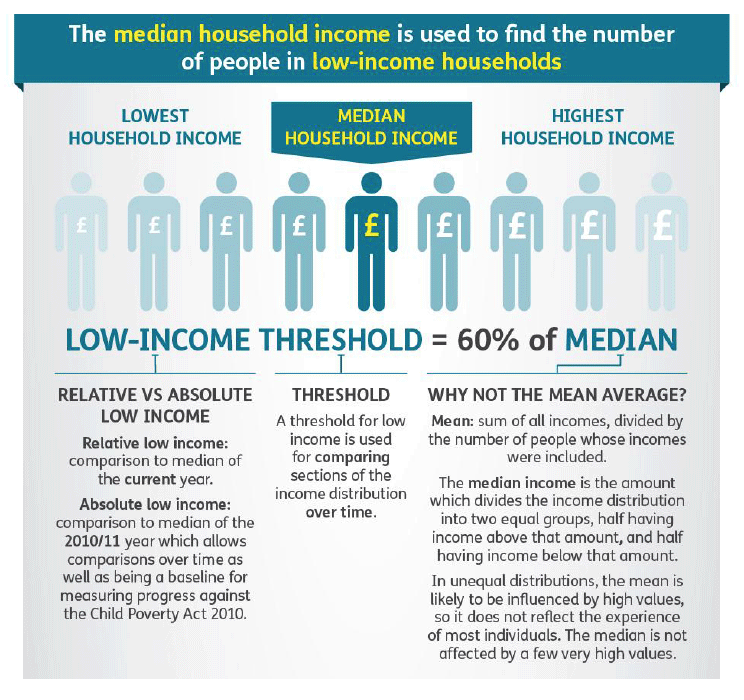
1.1 Individuals in poverty
- In 2012/13, 16 per cent of Scotland’s people were living in relative poverty (BHC), an increase from 14 per cent in 2011/12.
- 820 thousand people were living in relative poverty (BHC) in Scotland in 2012/13, 110 thousand more than in the previous year.
- Several key factors have affected household incomes in 2012/13. These are discussed within the relevant sections below.
The figures above are based on income 'Before Housing Costs' (BHC); changes in income 'After Housing Costs' (AHC) are given later in the text.
The Scottish Government's National Indicator 35 is to "decrease the proportion of individuals living in poverty":
http://www.scotland.gov.uk/About/Performance/scotPerforms/indicator/poverty
This is measured using relative poverty before housing costs (BHC).
Charts 1A and 1B below show Scottish trends for relative and absolute poverty for all individuals between 1998/99 and 2012/13.
Chart 1A - Relative Poverty - All Individuals
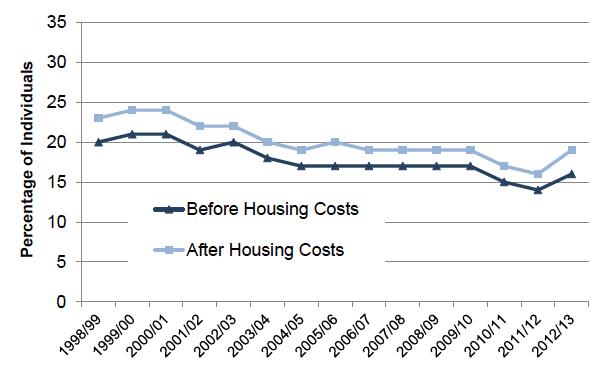
Chart 1B - Absolute Poverty - All Individuals
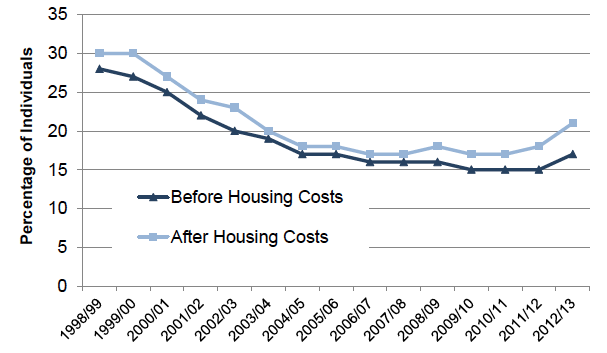
Source: HBAI dataset, DWP. See Annex 1 (Tables A1 and A2) for the figures behind these charts.
Charts with confidence intervals for relative and absolute poverty can be found in Confidence Intervals Surrounding Key Poverty Estimates
Note: The grossing factors have been updated to incorporate the 2011 census results. The previously published statistics have been revised to reflect the population since the 2001 census. Further information is available in Annex 3
In 2012/13, relative poverty (BHC) for all individuals increased to 16 per cent, a 2 percentage point increase compared with 2011/12. In 2012/13, there were 820 thousand people living in relative poverty (BHC) in Scotland, 110 thousand more than the previous year.
The change in the number and percentage of people in relative poverty (BHC) between 2011/12 and 2012/13 is statistically significant. Longer term trends often offer a better indication of significant changes, and prior to 2012/13 there had been periods of declining poverty rates for all groups in the population. Although there has been an increase in poverty this year, it is not yet clear if this is the start of a significant upward trend.
After Housing Costs have been taken into account, 19 per cent of people in Scotland were in relative poverty, a 3 percentage point increase compared with 2011/12. In 2012/13, there were 1 million people living in relative poverty (AHC), 140 thousand more than the previous year. Relative poverty AHC had remained unchanged since 2006/07 at 19 per cent before decreasing to 16 per cent between 2009/10 and 2011/12. This decrease has now been reversed.
Absolute poverty, a measure of whether the lowest income households are keeping pace with inflation, has increased in 2012/13 (both BHC and AHC). Absolute poverty (BHC) increased from 15 per cent in 2011/12 to 17 per cent in 2012/13, an increase of 100 thousand people. This represents 880 thousand people living in absolute poverty (BHC) in 2012/13. As absolute poverty is based on the poverty threshold in 2010/11, and incomes have decreased in real terms since then, absolute poverty rates are now higher than relative poverty rates.
Commentary:
Relative poverty increased in 2012/13. This reflects a number of changes such as: changes in the labour market and employment patterns, continued welfare reform (such as tightening of eligibility for tax credits for couples in employment and freezing of some elements of benefits and tax credits), increases in the personal tax allowance, and decreases in average earned income in the latest year. These factors have varying impact on the rate of poverty with some, such as increasing the personal tax allowance, mitigating the impact of others. The net effect however is an increase in relative poverty.
There was a fall in median income in Scotland in 2012/13 compared with the previous year. While income decreased for most households, the poorest households had the largest percentage decreases in household income in 2012/13. There were small increases in the top two income deciles, the only income deciles to show an increase 2012/13. Income for working age people, and for households with children, fell in 2012/13, while those for pensioner households increased. There were also differences dependent on whether households were in employment or not, and for those in employment, whether they had the opportunity to increase hours worked.
Income from earnings for those at the median income in Scotland increased overall in 2012/13, but fell for those on the lowest incomes. Increases in hourly pay in Scotland varied significantly depending on the sector and skill level of employment. There was little or no growth in hourly earnings for those in lower paid employment.
Over the last decade, relative poverty (BHC) in Scotland decreased steadily from 20 per cent in 2002/03 to 14 per cent in 2011/12, followed by an increase in the latest year. There was little progress in reducing relative poverty between 2004/05 and 2009/10, with rates remaining flat. The decreases in relative poverty in 2010/11 and 2011/12 were largely due to falling median incomes, rather than any material improvement in people's lives.
Low-Income Poverty Indicators
The Scottish Government currently uses two main indicators of low-income poverty, both of which reveal slightly different information about changes in poverty over time. These indicators are relative and absolute poverty.
Relative poverty:
Relative poverty is a measure of how many people are living below a defined income threshold in the most recent year. In this report, individuals are said to be in relative poverty if they are living in households whose equivalised income is below 60 per cent of UK median income in that year. Relative low income rates fall if household income for the poorest households increases faster than median income. In 2012/13, the relative poverty threshold for a couple with no children was an income of £264 per week (BHC) from all sources (see Annex 2 for further information on income definitions). For a couple with children the threshold would be higher and for a single person (without children) the threshold would be lower.
Absolute poverty:
Absolute poverty is a measure of whether income for the lowest income households are keeping pace with inflation. Individuals are said to be living in absolute poverty if they are living in households whose equivalised income is below 60 per cent of the (inflation adjusted) median income in 2010/11. In 2012/13 the absolute poverty threshold for a couple with no children was an income of £272 per week (BHC) from all sources (see Annex 2 for further information on income definitions).
1.2 Child poverty
Key points:
- In 2012/13, 19 per cent of Scotland‟s children were living in relative poverty (BHC), an increase from 15 per cent in 2011/12.
- 180 thousand children were living in relative poverty (BHC) in Scotland in 2012/13, 30 thousand more than in the previous year.
- The percentage of children in combined material deprivation and low income increased from 9 per cent to 11 per cent. In 2012/13, there were 110 thousand children living in combined low income and material deprivation, 20 thousand more than the previous year. For this measure, the low income threshold is defined as 70 per cent of UK median income.
- Incomes for households with children fell in 2012/13 reflecting low wage growth, tightening of eligibility and conditionality for benefits and tax credits under welfare reform, and individual households ability to increase their hours worked.
Child poverty is commonly measured using the following indicators:
- relative poverty (BHC),
- absolute poverty (BHC),
- material deprivation and low income (BHC) combined.
These are three of the four poverty indicators which the UK parliament is required to report on by the 2010 Child Poverty Act. There is also a persistent poverty indicator in the Act but the precise target is yet to be defined. Information on the targets for the Child Poverty Act can be found in Annex 1.
The Scottish Government's National Indicator 36 is to "reduce children's deprivation":
http://www.scotland.gov.uk/About/Performance/scotPerforms/indicator/childdeprivation
This is measured using the material deprivation and low-income combined poverty indicator.
Chart 2 below presents recent Scottish poverty trends for these three child poverty indicators.
Chart 2 - Child Poverty in Scotland: 1998/99 - 2012/13
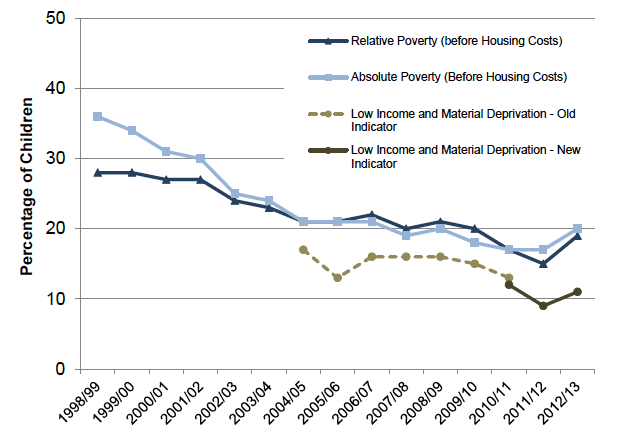
Source: HBAI dataset, DWP. See Annex 1 (Tables A1, A2 and A3) for the figures behind these charts.
Notes:
1. A version of this chart showing the Child Poverty Act target s can be found in Annex 1, Chart A14.
2. Charts with confidence intervals for relative and absolute child poverty can be found in Confidence Intervals Surrounding Key Poverty Estimates.
3. Changes in the material deprivation questions in 2010/11 created a break in the series. Data for 2010/11 onwards is not directly comparable with that prior to 2010/11. Further information is available in Annex_2
4. The grossing factors have been updated to incorporate the 2011 census results. The previously published statistics have been revised to reflect the population since the 2001 census. Further information is available in Annex 3
In 2012/13, relative child poverty (BHC) increased to 19 per cent, a 4 percentage point increase compared with 2011/12. This reverses the downward trend in child poverty over recent years. In 2012/13, there were 180 thousand children living in relative poverty (BHC), 30 thousand more than the previous year.
The change in the number and percentage of children in relative poverty (BHC) between 2011/12 and 2012/13 is not statistically significant. As this is the first increase in child poverty after 3 years of a decreasing trend, it is not yet clear if this is the start of a significant trend.
After Housing Costs, relative child poverty increased to 22 per cent, a 3 percentage point change compared to the previous year. In 2012/13, there were 220 thousand children living in relative poverty (AHC), 30 thousand more than in 2011/12.
The percentage of children in absolute poverty (BHC) in 2012/13 was 20 per cent, an increase from 17 per cent in 2011/12. This represents 200 thousand children living in absolute poverty (BHC) in 2012/13, 30 thousand more than in 2011/12.
In 2012/13, 11 per cent of children in Scotland were living in combined low income and material deprivation, a 2 percentage point increase compared with 2011/12. This equates to 110 thousand children living in combined low income and material deprivation in 2012/13, 20 thousand more than the previous year.
Commentary:
The increase in child poverty in the latest year is driven by a fall in household incomes for working households with children. For households in employment, the reduced entitlement to tax credits has contributed to a fall in household incomes for those with lower earnings who were unable to increase the number of hours worked. At April 2013, there was a 26 per cent decrease in the number of children in households in Scotland in receipt of in-work tax credits, compared with April 2012. There was little change in the number of children in households in receipt of out-of-work tax credits, or for households without children, in receipt of tax credits. Households with children may not have the opportunity to increase hours worked, or to work more flexibly, compared with households without children.
The introduction of other changes to benefits and tax credits in April 2012 have also affected household income. Changes to benefits and tax credits specifically affecting families with children included:
- freezing the basic element of working tax credits,
- increasing the minimum number of hours worked from 16 to 24 to qualify for tax credits for couple families,
- freezing the income threshold for child tax credits at 2011 levels,
- abolishing the second income threshold for child tax credits,
- the introduction of the income disregard for tax credit, affecting those whose income was falling.
For those in employment, increases in earned income were dependent on the employment adults were in: while median annual earnings for all employees in Scotland increased 2.8 per cent between 2012 and 2013 (a fall in real terms), increases in hourly pay varied from 0.5 per cent in less skilled employment, 1 per cent across the public sector, with larger increases for some sectors, and higher skilled employment.
Over the last decade, the proportion of children in Scotland living in relative poverty (BHC) has decreased by 10 percentage points from 24 per cent in 2002/03 to 15 per cent in 2011/12, before increasing again in the latest year. After decreasing to 2004/05, relative child poverty (BHC) remained largely unchanged before decreasing significantly between 2009/10 and 2011/12.
Much of the fall in child poverty up to 2011/12 in Scotland was due to a fall in the high poverty rate among lone-parent households. This was likely to be due to an increase in employment rates for lone parents in Scotland over the last decade, as well as policies that have sought to address poverty in this group. Employment rates for two parent households have also increased over the last decade, contributing to a fall in child poverty among working-couple parents, as more couple households move into 'full' working (where both adults are in work and at least one of them is working full time). Poverty for children in workless households in Scotland remains high.
Households not in employment are significantly more likely to be dependent on benefit income as the only source of income. Up to 2010/11, some benefits relating to households with children were uprated at a faster rate than other benefits, however these increases were still not as large as the increase in average earnings in real terms. In 2012/13, a number of benefit changes, although having different effects on different households, resulted in smaller growth in real benefit income than may have been expected from the level at which benefits were uprated. Again this year, low wage growth has meant benefits have increased faster than earned income. However in the latest year, eligibility and conditionality have been tightened under welfare reform, meaning fewer households with children were in receipt of tax credits.
Material Deprivation and Low-Income Combined Poverty Indicator:
Material deprivation is calculated from a suite of questions in the Family Resources Survey about whether people can afford to buy certain items and participate in leisure or social activities. This measure is applied to households with incomes below 70 per cent of UK median income (£308 per week) to create the 'material deprivation and low income combined' indicator. This indicator aims to provide a measure of children's living standards which, unlike relative and absolute poverty, is not solely based on income.
For more detail about this indicator see Annex 2.
1.3 Working age adult poverty
Key points:
- In 2012/13, 15 per cent of working age adults were in relative poverty (BHC) in Scotland, an increase from 13 per cent in 2011/12.
- 480 thousand working age adults were living in relative poverty (BHC) in Scotland in 2012/13, 70 thousand more than in the previous year.
- Household incomes for working age families fell in 2012/13, but there were differences based on household type, employment status, and hours worked.
Charts 3A and 3B below present relative and absolute poverty trends for working age people in Scotland.
Chart 3A - Relative Poverty - Working Age Adults
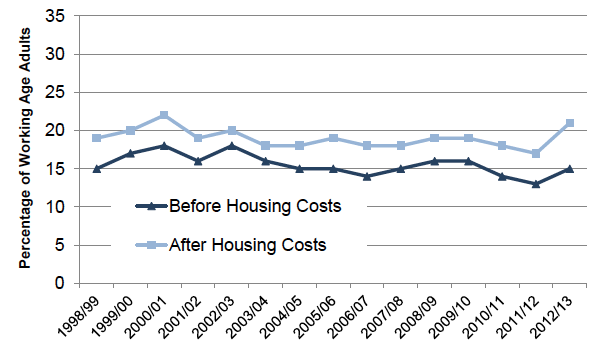
Chart 3B - Absolute Poverty - Working Age Adults
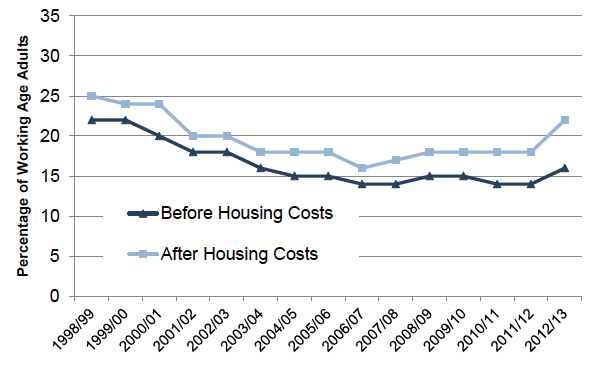
Source: HBAI dataset, DWP. These figures are also presented in Annex 1 (Tables A1 and A2).
Charts with confidence intervals for relative and absolute working age adult poverty can be found in Confidence Intervals Surrounding Key Poverty Estimates
The grossing factors have been updated to incorporate the 2011 census results. The previously published statistics have been revised to reflect the population since the 2001 census. Further information is available in Annex 3
In 2012/13, 15 per cent of working age adults in Scotland were living in relative poverty (BHC). This increase reverses the falling trend in relative poverty for working age people in Scotland seen in recent years. In 2012/13, there were 480 thousand working age adults in Scotland living in relative poverty (BHC), 70 thousand more than the previous year.
The change in the number and percentage of working age adults in relative poverty (BHC) between 2011/12 and 2012/13 is not statistically significant. As this is the first increase in child poverty after 2 years of a decreasing trend, it is not yet clear if this is the start of a significant trend.
After Housing Costs, relative poverty for working age adults increased to 21 per cent in 2012/13, an increase from 17 per cent in 2011/12. In 2012/13, 660 thousand working age adults were living in relative poverty (AHC), 110 thousand more than in 2011/12. The percentage of working age adults in relative poverty (AHC) had remained largely unchanged since 2002/03 but is now at the highest level in the last ten years.
The percentage of working age adults in absolute poverty (BHC) in 2012/13 was 16 per cent, an increase from 14 per cent in 2011/12. This represents 510 thousand working age adults living in absolute poverty (BHC) in 2012/13, an increase of 60 thousand from 2011/12. The percentage of working age adults in absolute poverty (BHC) has remained largely unchanged since 2004/05, following a significant decrease between 1998/99 and 2003/04. The increase in 2012/13 reverses this trend.
Commentary:
Over the last decade, the proportion of working age adults in Scotland living in relative poverty (BHC) has decreased by 5 percentage points from 18 per cent to 13 per cent. The percentage of working age adults in relative poverty increased slightly between 1998/99 and 2002/03, remaining largely unchanged until 2009/10. There had been a small decrease since 2009/10, but following the increase in 2012/13, relative poverty levels are similar to those throughout most of the last decade.
Incomes for households with children and at least one adult in employment fell. The number of households with children in employment and in receipt of in-work tax credits fell as a result of tightened eligibility and conditionality under welfare reform. Households with children may have more limited ability to increase work hours, or to work flexible hours, meaning households with children may not have been able to remain in receipt of tax credits. The number of working age adults with children in receipt of out-of-work tax credits is largely unchanged, as is the number of working age adults without children in receipt of tax credits.
In 2012/13, household income for working age households without children fell, although at a slower rate than for households with children. This group may be more likely to increase the number of hours worked and have greater flexibility in the labour market than households with children.
Over the year to March 2013, there was a small increase in the number of adults in employment compared with the previous year. However there have been changes within the labour market: the number of women in full time employment increased in the last year, as did the number of men in part time employment.
The number and proportion of low paid jobs in Scotland decreased between 2004 and 2013. Median earnings for all employees (part time and full time) in Scotland have mirrored the pattern for the UK, with the gap between median earnings in Scotland and the UK narrowing in more recent years. However, increases in hourly pay rates in 2012/13 in Scotland depended on the sector and skill level of employment. Those in lower paid employment (and with the lowest household incomes) saw no real increases in earned income.
Historically, earnings have tended to rise in real terms and hence outstrip price-indexed benefit rates. However, out-of-work benefit rates have grown substantially faster than earnings since 2007 essentially reflecting the fact that earnings have not kept pace with inflation, whereas rates of out-of-work benefits have risen broadly in line with prices (though there have been discretionary cuts to the rates of other benefits and tax credits). However, in 2012/13 tightening of eligibility and conditionality to tax credits, freezing some elements of benefits, such as child benefit and tax credits, changes to local housing allowance, along with low growth in earned income, have resulted in falling incomes for working age households.
Working age vs. State pension age:
Working age adults are defined as all adults up to the state pension age. Prior to April 2010, women reached the state pension age at 60. Between April 2010 and March 2016 the state pension age for women is increasing to 63 and will then increase to 65 between April 2016 to November 2018. The changes do not affect the state pension age for men, which remains at 65. Further increases are planned for both men and women's state pension age (to 66 by 2020 and 67 by 2028). The impact is to retain women in the working age adult group, who prior to April 2010 would have been classified as pensioners.
1.4 Pensioner poverty
Key points:
- In 2012/13, 15 per cent of pensioners were living in relative poverty (BHC), an increase from 14 per cent in 2011/12. This has remained relatively unchanged since 2008/09.
- 150 thousand pensioners were living in relative poverty (BHC) in Scotland in 2012/13, 10 thousand more than in the previous year.
- The percentage of pensioners in material deprivation was 8 per cent in 2012/13, the same as the previous year. In 2012/13, there were 70 thousand pensioners living in material deprivation.
- In 2012/13, state pensions were increased in line with other benefits and tax credits. However there were reductions in the maximum award for savings credit.
Charts 4A and 4B present recent trends for the three main pensioner poverty indicators: relative poverty, absolute poverty and the material deprivation indicator. Note that poverty based on income After Housing Costs (AHC) is a more commonly used measure for pensioner households, as many have low housing costs. Further discussion on whether it is better to use before or after housing costs can be found in Annex 2.
Chart 4A - Relative Poverty and Material Deprivation - Pensioners
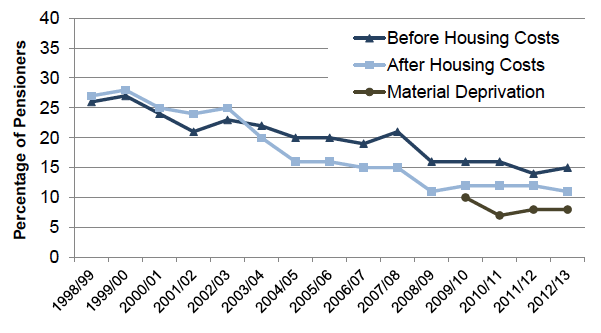
Chart 4B - Absolute Poverty and Material Deprivation - Pensioners
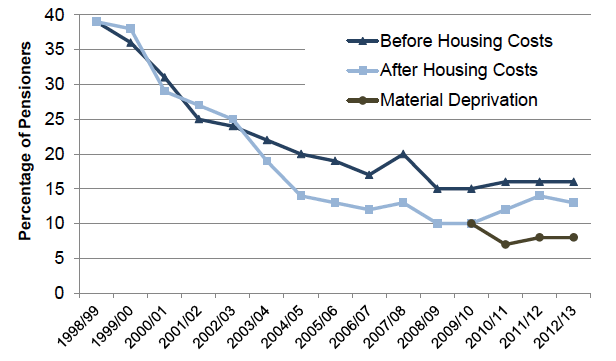
Source: HBAI dataset, DWP. These figures are also presented in Annex 1 (Tables A1 and A2 and A4).
Charts with confidence intervals for relative and absolute pensioner poverty can be found in Confidence Intervals Surrounding Key Poverty Estimates.
Notes:
1. Pensioner material deprivation is not solely based on affordability and so should not be compared directly with measures of income-related poverty.
2. Pensioner material deprivation is included for those aged 65 and over only and therefore is not the same population as relative and absolute poverty measures.
3. The grossing factors have been updated to incorporate the 2011 census results. The previously published statistics have been revised to reflect the population since the 2001 census. Further information is available in Annex 3
In 2012/13, 15 per cent of pensioners in Scotland were living in relative poverty (BHC), a 1 percentage point increase compared with the previous year. In 2012/13, 150 thousand pensioners in Scotland were living in relative poverty (BHC), 10 thousand more than the previous year.
The change in the number and percentage of pensioners in relative poverty (BHC) between 2011/12 and 2012/13 is not statistically significant. Pensioner poverty saw the smallest increase since 2011/12 and so caution should be used when interpreting this as a change.
After housing costs have been taken into account, 11 per cent of pensioners were in relative poverty, a decrease from 12 per cent in 2011/12. In 2012/13, 120 thousand pensioners were living in relative poverty (AHC), unchanged from the previous year. This percentage has remained largely unchanged since 2008/09, following a significant decrease in pensioner poverty between 1998/99 and 2004/05. There was a decrease between 2004/05 and 2008/09, but at a slower rate.
Absolute poverty (BHC) for pensioners was 16 per cent in 2012/13, unchanged from the previous year. There were 170 thousand pensioners living in absolute poverty (BHC) in 2012/13. This percentage has remained unchanged over the last five years, following a decrease in 2008/09.
In 2012/13, 8 per cent of pensioners in Scotland were living in combined low income and material deprivation, unchanged from 2011/12. In 2012/13, there were 70 thousand pensioners living in combined low income and material deprivation.
Commentary:
Over the last decade, the proportion of pensioners in Scotland in relative poverty (BHC) has fallen 8 percentage points from 23 per cent in 2002/03 to 15 per cent in 2012/13. The fall in pensioner poverty over the last decade has been steeper than comparable falls for children and working age adults.
Households containing pensioners at the lower end of the income distribution generally received a larger proportion of their income from benefits and a smaller proportion from other sources. In the latest year, because benefit income grew more than earned income, households with pensioners saw their overall income increase in real terms while other households with more income from earnings saw incomes decrease. The Basic State Pension and Pension Credit Guarantee Credit increased by 5.2 per cent, in line with increases in other benefits and tax credits. However in 2012 the maximum award of Savings Credit was reduced (following freezes in 2011).
From the early 1980s until 2011/12, the Basic State Pension (BSP) was uprated in line with prices using the Retail Prices Index (RPI), and since then, in line with the Consumer Price Index (CPI). Although this protected it from inflation, the income that pensioners received from BSP fell behind that of working age people, as the earnings of working age people tended to increase faster than inflation. However, inflation in the UK has exceeded the growth in average earnings in recent years, and so pension increases have been greater than earnings and most other benefits and tax credits.
From 2009, BSP income has increased faster than earnings for working age households, and at a faster rate than for most other benefit and tax credit income. Pensioners' median net income has grown faster than earnings over the last twelve years. Median income after housing costs for pensioners has grown by 18 per cent between 2002/03 and 2012/13 in real terms, whereas average weekly earnings for the whole economy rose by 5 per cent in real terms over the same period.
Pensioner Material Deprivation Indicator:
This is an additional way to measure the living standards of pensioners. This measure is based on a set of goods, services and experiences, judged using academic research to be the best discriminators of deprivation. Pensioners are asked if they have an item (or access to a service) and to give a reason if they do not have it. Their responses are then used to judge whether or not they are materially deprived. It is similar to the child material deprivation and low income combined indicator (which is presented in Chart 2) but has some important differences:
- Differences in the set of items asked about, e.g. pensioners are not asked if they can afford school trips.
- Pensioners are presented with a greater variety of reasons for not having a particular item, whereas households with children are simply asked whether they can afford an item they do not have. Pensioners are able to say if they are prevented from having it due to ill health, disability or lack of support from other people. These additions reflect that deprivation can occur because of ill health, disability or social isolation, and not just for financial reasons.
- The pensioner "material deprivation" indicator is not combined with household income information to produce a combined indicator, as is done with the child deprivation indicator. This is because for pensioners, the concept of material deprivation is broad and very different from low income, so it is appropriate to present it as a separate measure.
For these reasons, pensioner material deprivation cannot be directly compared to the child material deprivation and low income measure.
More background on pensioner material deprivation is given in Annex 2, and the following technical note on the DWP website gives further information, including the list of questions which are asked to pensioners:
State pension age:
Working age adults are defined as all adults up to the state pension age. Prior to April 2010, women reached the state pension age at 60. Between April 2010 and March 2016 the state pension age for women is increasing to 63 and will then increase to 65 between April 2016 to November 2018. The changes do not affect the state pension age for men, which remains at 65. Further increases are planned for both men and women's state pension age (to 66 by 2020 and 67 by 2028). The impact is to retain women in the working age adult group, who prior to April 2010 would have been classified as pensioners.
As such material deprivation is presented here for pensioners aged 65 and over only.
1.5 In-work relative poverty (BHC)
Key points:
- In 2012/13, 52 per cent of working age adults in poverty were in in-work poverty.
- In 2012/13, there were 250 thousand working age adults in in-work poverty.
- In 2012/13, 59 per cent of children in poverty in Scotland in 2012/13 were living in families where at least one adult was in employment.
- In 2012/13, there were 110 thousand children living in poverty who were in families in employment.
- 45 per cent of all people in poverty in Scotland were in in-work poverty.
- In 2012/13 the rate of in-work poverty increased compared with 2011/12.
Chart 5 compares Scottish in-work poverty trends for children and working age adults.
Chart 5 - Percentage of children and working age adults in poverty, living in a household with at least one adult in employment
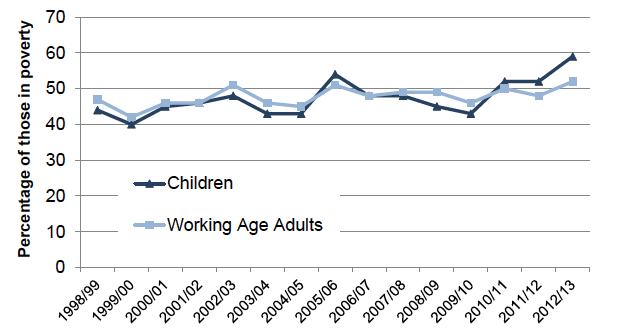
Source: HBAI dataset, DWP. These figures are also presented in Annex 1 (Table A5).
Note: The grossing factors have been updated to incorporate the 2011 census results. The previously published statistics have been revised to reflect the population since the 2001 census. Further information is available in Annex 3
Commentary:
In-work poverty in Scotland increased in 2012/13, with 250 thousand working age adults living in in-work poverty. Over half (52 per cent) of working age adults in poverty were living in in-work poverty in 2012/13. This is an increase of 50 thousand working age adults in in-work poverty, compared with the previous year, and continues the slow upward trend in working age in-work poverty in Scotland.
The number of children living in poverty who were in households in employment has also increased in the latest year, with 110 thousand children in Scotland living in in-work poverty in 2012/13. Six in ten children in poverty in Scotland in 2012/13 were living in households where at least one adult was in employment. There were 30 thousand more children in in-work poverty in 2012/13 compared with the previous year, continuing the upward trend in children in in-work poverty in Scotland.
In-work poverty:
'In-work poverty' refers to those individuals living in households where at least one member of the household is working (either full or part time) but where the household income is below the relative poverty (BHC) threshold. This group contains non-working household members such as children and non-working partners.
Contact
Email: Stephen Smith
There is a problem
Thanks for your feedback